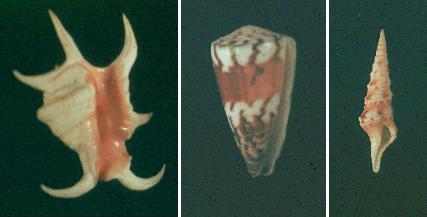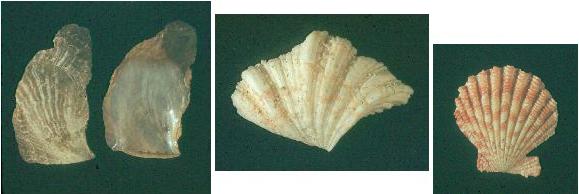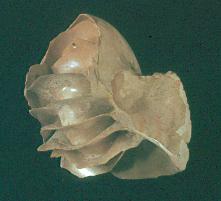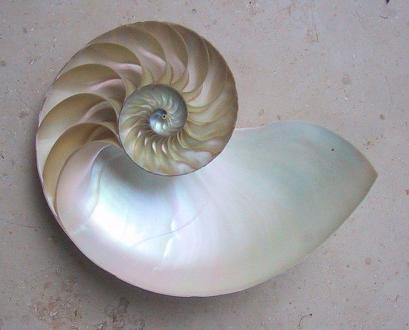SHELL (Mollusca) -- See also
Mother-of-Pearl
(Fr-coquille - e.g., coquille
Saint-Jacques =
Scallop shell &
coquille d'escargot = snail shell;
Ger-Schale
(Molluske);
Nor-skall/skjell/konkylie-?; Rus-раковина-?)
A. Shell. A.Gastropods,
left to right: Spider shell (Lambis chiragra Linneaus, 1758), Imperial cone (Conus imperialis Linneaus, 1758) and a Turret
shell - This one is also illustrated in black and white (Dietrich &
Morris, 1953: Plate 4, Figure 10) among "Species ... that are unusual
or not figured in readily available conchology books," and is
identified as Turris sp.,
which Morris considered to be a Genus (attributed to Bolten, 1798) in
the family Turridæ; I have wondered if it
possibly in a member of the family Fasciolariidæ, perhaps Fusinus Rafinesque, 1815 sp. (photo
by Percy Morris) --
Photographs of other gastropods on this web site show the tapestry turban (Turbo petholatus Linnaeus, 1758) in the Cat’s Eye
Opercula entry; the abalone (Haliotis Linnaeus, 1758 sp.), paua (Haliotis iris Gmelin,JF, 1791) and trochid
gastropod (Trochus niloticus
Linnaeus, 1767) in the Mother-of-Pearl entry; and the pink Queen
conch
(Strombus gigas Linnaeus,
1758) and tiger cowrie (Cypraea tigris
Linnaeus, 1758) in this entry.
A. Shell.
B.Bivalves (Pelecypods), left to right: pearl oyster (Pinctada vulgaria Schumacher, 1817), sand clam (Hippopus hippopus Linneaus 1758) and zigzag
scallop (Pallium pallium
Linnaeus, 1758). (photo
by Percy Morris) --
Photographs of other bivalve shells on this web site are the plain
pocketbook (Lampsilis cardium
Rafinesque, 1820) in the frontispiece; and the pearl oyster (Pinctada maximus Jameson, 1901) and
yellow sandshell mussel (Lampsilis
teres Rafinesque, 1820) in the Mother-of-Pearl entry.
A. Shell. C.Cephalopd -- a damaged
chambered nautilus
(Nautilus pompilius Linnaeus,
1758).
(photo
by Percy Morris) -- See also photograph
of a sliced shell of this species in this entry (Figure D).
All shells shown in Figure A
were
collected on Kwajalein atoll of the Marshall Islands during World War
II by
RVD, identified and photographed by Percy A. Morris during the
1947-1948 academic year, and are
included here for "old time's sake." -- Colored slides of all of the
shells
described in Dietrich and Morris (1953) are in compiler's archives.)
DESCRIPTION: The Phylum Mollusca
includes four classes*(see Addendum at end of this section) used rather
widely in jewelry and/or decorative objects:
Gastropoda -- e.g.,
snails; Bivalvia (=Pelecypoda) --
e.g., clams, mussels and
oysters; Cephalopoda --
e.g.,
nautiluses; and Scaphopoda -- e.g., tusk
shells. Most mollusc shells consist primarily of
calcium carbonate (CaCO3),
typically aragonite (+
minor calcite), plus an organic matrix. “The
shells of most molluscs (including all
gastropods and bivalves) have a thin, outer organic layer (the
periostracum), a thin, innermost calcareous layer (the nacreous
layer) and a thick, calcareous middle layer (the prismatic
layer). ...Organic
material [frequently referred to as conchiolin, which is protein] may
comprise about 35% of the shell’s dry weight
in some gastropod species and up to 70% of the dry weight in
bivalves...”
(Pechenik, 2005, p.207). Although the calcium
carbonate of, for example, most gastropod
shells is aragonite, it may be calcite
and/or aragonite in the shells of any given species; sizes,
shapes
and typically layered arrangements of the crystalline units of many
species have been studied, described and illustrated
(for the most part by electron micrographs) – see, for example
Carter(1980a) and Teichert
(1964). Nacre is the component
of the most sought after shells because of its wide utilization in
jewelry and decorative
pieces.
Colors - White, red, orange,
yellow, green, blue, violet, brown, black and gray; the colors,
typically only two or three on the shells of any given species, occur
in patterns.
H. (effective hardness) - 2½
- 4½
S.G. - 2.65 - 2.84
(depending
upon sample size and method of measurement; the point is that
when dry
some shell is fairly porous, etc.)
Light transmission -
translucent to opaque
Luster - dull, pearly to
vitreous
Breakage - varies
with
species from irregular to
conchoidal
Miscellaneous - Most
shells effervesce with
HCl (hydrochloric
acid). Mother of pearl, common to the nacre layer of many
molluscs, exhibits several colors that frequently comprise a "play of
colors," which is the attractive, apparently moving multicolored
appearance that is seen when the surfaces are viewed as the angle
of incident light is varied. (The term pearlescence, applied by some
marketers to what appears best described as slight "play of colors"
seems to me to be a good candidate for abandonment!)
Incidently, both the toughness of
the shell of the queen conch (Strombus gigas Linnaeus,
1758) and
the rather frequently observed apparent repairs of damages of these
shells have been found to depend upon the microarchitecture
of the shell (Ballarini and
Heuer, 2007).
* Addendum -
Beads have been fashioned from chiton (class, Polyplacophora) shells: "The
shells of two chitons from the Caribbean were polished and glued
together, then wrapped with a yellow metal wire to form ...
approximately 3-cm-long beads. ... [Their color was a] delicate
blue-gray ... reminiscent of pumpellyite at first glance." Johnson et al. (2000, p.67)
OTHER NAMES: Shell material
used in jewelry and/or to fashion decorative objects is sometimes
identified by the common or scientific name of the
animal that secreted the given material. The following are a few
examples, with
most of the names taken from Abbott and Morris (1995):
- Abalone
(also called "ear
shells" -- family Haliotidae) - These gastropods from the Pacific -- e.g., off California and Mexico -- are used widely
as a source of colorful nacreous material used in inlays etc.
- Capiz
(sometimes spelled Kapiz; also called the "window pane shell") -
This is the Bivalvia (=Pelecypoda), Placuna placenta (Linnaeus, 1758).
Its
popular name is apparently from the Capiz Province of the
Philippines, where it occurs in the shallow coastal water of Sibuyan
Sea; it occurs widely from the Gulf of Aden in the Indian Ocean
as well as in the western Pacific. The shells, which
have a pearly luster and are nearly transparent, are used widely in
decorative accessories, especially those through which light is
transmitted, and jewery.
- Conchs
(family Strombidae) - These gastropods, all of which are marine,
include those used for such diverse things
as horns,
tools (e.g., scrapers) and even
doorstops as well as being the "rough" from which shell cameos
have been fashioned.
- Coque de perle - name sometimes
given in the marketplace, especially in the past, to sections of
nautilus
shells.
- Coquille St. Jacques - name given
scallop shell used as the symbol of St. James the Great of Compostela
and worn on the hats or carried by devotees on their pilgrimages to
Santiago de
Compostela, Spain (Craig A.Gibson, personal communication, 2006).
- Cowries
(family
Cypraeidae)
- These gastropods, all of which are marine, have been used widely
in the south Pacific for fashioning necklaces
and other pieces for adornment and, in the past, as currency.
- Jingle
shells (family
Anomiidae) - These bivalves (pelecypods) have long been strung and hung
where even a slight breeze makes them knock against each other and, as
one might guess, jingle(!).
- Mussels
(family
Mytilidae) -These bivalves
(pelecypods) are the tasty morsels that pretty Molly Malone of Dublin
City sold, along with cockles, from her wheel barrow "alive, alive, oh."
- Nautilus
(family Nautilidae) - These cephalopods, chiefly of the south-western
Pacific, are extremely attractive, especially if sliced, display pieces
(see Figure E
and the fourth comment in the third paragraph of the REMARKS.).
- Paua (Haliotis sp. Linnaeus, 1958)
- These gastropods from New Zealand, which
are close
relatives of
abalones, have found use in jewelry
and several diverse items, most of which are sold as souvenirs.
- Quahogs
(family
Veneridae)
- These marine bivalves (pelecypods) are common and consequently one of
the best-known clams. A rather remarkble use of these shells is
their presence as the predominant shell within the mortar of external
veneers on buildings, typically shops that market shells and
miscellaneous "seaside" souvenirs.
- Scallops (family
Pectinidae) -These bivalves
(pelecypods) are well known because of their use as the trademark of
Shell
Gasoline.
- Slipper
shells (family
Crepidulidae) - These gastropods include the shell that children like
to use as small scoops while playing in the
sand.
- Tooth
(or tusk) shells (family Dentaliidae)
- These scaphopods were used in the past for adornment and money,
especially by Amerindians of what is now the north-western United
States
and British Columbia, Canada.
- Turbans (family
Turbinidae) - These gastropods include the species Turbo petholatus Linnaeus, 1758, the opercula of which
constitute shell
cat's eyes - see CAT’S EYE
OPERCULUMS entry.
USES:
As the
old tongue twister goes “She sells seashells by the seashore”
(or if you prefer an update: “If neither he sells seashells nor she
sells seashells, who shall sell seashells down by the seashore?”)
In any case, the
seashell industry is a multimillion dollar enterprise each year:
Shops with literally thousands of shells are at nearly every seashore
resort along, for example, the Atlantic and Gulf of Mexico coasts of
south-eastern the United States, and “Seashell Cities” shops with
inventories of some the shops running into hundreds of thousands of
shells(!) are located here and there throughout the country. So,
what is
the use of these shells? ((Before continuing, however, it
seems prudent to repeat that, with a few exceptions,
information
relating to uses of fossil shells is not given
here; see the
Fossiliferous Rocks entry in the GEMROCKS folder on this web
site for such uses.))
Jewelry: Parts of several
shells have been ground to spheres, carved, tumbled or otherwise shaped
for use as beads or as parts
of bracelets, cuff links, earrings,
necklaces, pendants, studs, etc.
Cowries (Cypraea sp.), especially small
ones,
have been used "as
is" rather widely
for bracelets, necklaces, etc. -- apparently
because of
their durability as well as
their fairly widespread distribution.
A
rather attractive costume jewelry bracelet I recently saw featured
parts of several shells: It consisted of diverse geometric-shaped
pieces of patterned parts of
shells – e.g., cone shells (Conus sp.), olive shells (Olivella sp.) and volutes (Scaphella sp.) – set in silver with
silver links between each pair. Another recently
viewed bracelet consists of nested shells, strung on an elastic band,
that completely encircle the wrist of the person who wears it; I
would think such a bracelet would irritate the weaer's
wrist. Some relatively thick
shells have been made into so-to-speak
hololithic rings.
Perforated
marine gastropod shells (Swollen Nassa, Nassarius
gibbosulus Linnaeus, 1758) apparently used
as beads more than 100,000 B.P. were collected from two burial
sites,
one at Skhul, Israel, the other at
Oued Djebbana, Algeria (Vanhaeren et
al., 2006). "Tooth
shells" (class Scaphopoda, also called tusk shells)
were used in necklaces by the Natufians, the original
inhabitants of the Jordan River valley circa 10,000-8,000 B.C.
(Dubin 1987, p. 31) and, more recently, have found use by
the Inuits (ibid., p.264)
and the Sioux (ibid., p.278) for jewelry
and other
decorative objects, including beaded shirts. In Oceania, four
bracelets, some necklace pieces and nine rings made from shell,
apparently about 3,000 years ago, were recently found at the Bourewa
Beach settlement excavation site on the southwest coast of Fiji’s main
island; this jewelry is believed to have been fashioned by Lapita
people who migrated from the Bismarck Archipelago of New Guinea to Fiji
and other Pacific islands. (Ligaila, 2008). Today, Paua shells, long a favorite
part of objects of adornment etc.
by the Maori of New Zealand, are now made into all
sorts of jewelry and souvenirs. Several Amerindian
artists of the
south-western
deserts of the United States incorporate shells and red coral -- both
from
distant
marine sources -- into much of their multi-material jewelry (see Chalker,
2004) -- considering the source of these materials, this seems
sort of a geographical anomaly.
Since at
least the 15th century, shell cameos have been
fashioned from conch shells -- e.g.,
giant (=Queen) conchs (Strombus gigas Linnaeus,
1758) -- and
King helmet shells (Cassis tuberosa
(Linnaeus, 1758)) that consist of white plus one or
more layers of some other color; in general, a
white layer comprises the carved figure (i.e., a bas-relief) with the
colored background commonly orangish or pinkish brown (see
Figure B).
Unfortunately, the background color frequently fades when exposed to
light over extended or
cumulated periods of time. (In any case, shell cameos can be
distinguished
easily from agate cameos
by
macroscopic means -- e.g., they
have an inferior hardness and effervesce with dilute HCl.)
B. Shell Cameo
(height - 5.6 cm). Frances S. Dietrich collection. (© photo by Dick Dietrich)
Decorative
and functional objects frequently put on display include the
following:
Shells displayed as such, with or without labels; small and
larger collections are available at many places. *+*Originally
functional items made from shell, now frequently used as "show
pieces," included diverse shells and parts of shells used as boat
bailers, blades, cooking utensiles, game pieces, oil (holders)
lamps, and scrapers
(Conniff, 2009). Shell beads have
been "worked in" by embroiderers to
decorate cloths, purses, etc. Buttons,
especially in the past, have been made from several shells -- e.g., quahogs. Decorative items, many
of which constitute kitsch(!!), include boxes (for jewelry, kleenex, etc.), candles with shells
partially embedded in their wax, some rather intriguing candle holders
[These consist of, for example, fish shapes cut from the shell of the
windowpane oyster, Placenta placenta (Linne), with metal
rims around
their perimeters that are arranged and soldered to form
cyclinders.], lamp shades covered with copper-foiled seashells, lamp
bases, mobiles, perfume bottles, soap dishes,
wind chimes and wreaths, most of which are marketed in souvenir
shops. Shells, especially those that are rather colorful, are
common in aquariums. Diverse
individual and groups of shells that are inclosed in glass globes
became a "staple" on the market during the second decade of the 21st
century. Display quality shells
have (rightfully, in my opinion)
gained their places in museums, private collections and on, for
example, mantles and shelves of "whatnots." -- One needs only to look
at
the photographs of shells in some "coffee table" book (e.g., Stix, Stix & Abbot) to understand why
shells have gained such status. Along this
line,
sectioned chambered nautilus shells are outstanding (see Figure D).
Knives, magnifying glasses etc.
with handles that consist of whole shells
or fashioned from parts of some
shells are widely marketed. Horns ranging
from those
mentioned
in the fourth paragraph of the REMARKS to those played
as musical
instruments
by the well-known
trombonist Steve Turre are examples. Wampum – see the sixth paragraph of the REMARKS.
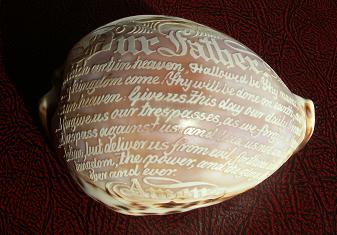
C. Shell. Carved tiger
cowrie (Cypraea tigris Linnaeus, 1758)
(width - 9.5 cm) with the Lord's Prayer carved in script on
it. This
shell dates to the 1800s. (© photo by Dick Dietrich)
D. Shell. Chambered nautilus (Nautilus pompilius Linnaeus, 1758)
sliced to show growth pattern, which is often cited as an example of a
logarithmic spiral that expresses the golden ratio --
see, however, the
fourth comment in the third paragraph of the REMARKS. (This
Wikipedia and Wikimedia Commons
image is from the user Chris 73 and is
freely available at http://commons.wikimedia.org/wiki/Image:NautilusCutawayLogarithmicSpiral.jpg
under
the creative
commons cc-by-sa 2.5 license. .)
A few additional uses are mentioned under
OTHER NAMES and attention is directed to the photograph of the dwelling
in Isla de Providencia (an island off Columbia) which is faced by queen
conch shells (Ballarini and Heuer,
2007, p.423). It also seems
noteworth that byssus,
"A mass of strong, silky filaments by which certain bivalve
mollusks, such as mussels, attach themselves to rocks and other
fixed
surfaces" (Houghton ..., 2000)
has been used to fabricate cloth for such things as gloves. To
date, however, I have been unable to determine the composition of these
filaments.
OCCURRENCES
& NOTEWORTHY LOCALITIES: Although several of
us beachcombers have collected shells here and there around the world,
nearly all shells used for jewelry and in decorative pieces are
obtained off-shore by professionals, frequently by diving.
Australia and Indonesia are major sources. See also
MOTHER-OF-PEARL entry.
REMARKS: The word shell has
many meanings. So far as its application to molluscs' shells, the
following
seems worthy of consideration: "O.E.[Old
English] sciell, scill, Anglian scell 'seashell,
eggshell,' related to O.E.[Old English] scealu "shell, husk," from
P.Gmc.[Proto-Germanic] skaljo "divide, separate"
(cf. W.Fris.[West Frisian] skyl 'peel, rind,'
M.L.G.[Middle Low German] schelle 'pod, rind, egg
shell,' Goth.[Gothic] skalja 'tile'), with the
notion of "covering that splits off," from P.I.E.[Proto-Indo-European]
base (s)kel- 'to cut, cleave'
(cf. O.C.S.[Old Church
Slavonic] skolika 'shell,'
Rus.[Russian] skala 'bark'). Sense of
"mere exterior" is from 1652; that of "hollow
framework" is from 1791...." (Harper, 2002).
The word mollusc (or mollusk, if you prefer) is from the "French mollusque from New Latin Mollusca
phylum name from neuter pl[ural] of Latin molluscus ... from mollis soft" (Houghton ..., 2000 cf. Q.E.D. extensive entymology),
apparently originally in reference to the fact that molluscs have soft
bodies.
A
quotation I consider noteworthy here follows: "By
... imaginative leaps, human beings can transform shells ... into
ritual objects, symbols, metaphors. The shell becomes a hiding
place, the sun, a womb. In our contemporary experience, we mainly
find this kind of metaphorical thinking in poetry. From European
literature some images of shell as a natural fortress, a grave, an
image of resurrection, a toothed vagina -- a small sample of the range
of analogies that the human mind can imagine." (Safer and Gill,
1982, p. 9 -- By the way, this "coffee table" type book contains some
remarkable photos and well documented text about the use of shells "in
daily life[,]... wealth[,]... as emblems of status ... [and] in ritual
and myth.")
Chlorox will
dissolve [away] the conchiolin of the proteinaceous matrix
of shells. Because of the relatively low hardness shell is
relatively easy to carve; because of its composition it is easily
etched. And, these two properties have led to the coating of
several products fashioned from shell with, for example, a
transparent plastic
to make their exposed surfaces
less likely to be marred. Shell has been dyed diverse
colors. (Along
this line, it is
interesting that some dyes, particularly in the past, were derived from
molluscs -- e.g., Tyrian
purple which was produced by crushing the bodies of certain members of
the family Muricidae, ...) Step-by-step
procedures for cleaning, dyeing and applying
metallic leaf to shells are described by Jones (2006). Alternative methods also have
given good results -- e.g.,
in the South Pacific, we found that burying live molluscs in the coral
sand and leaving them there for a few weeks resulted in their being
cleaned, having no odor and retaining their
luster -- i.e., ready to be used to fashion
whatever; we did not attempt to dye any of them because we liked
their natural colors.
Four bits of
trivia: 1.Most gastropods coil clockwise and are described
as dextral; those that coil counter-clockwise are characterized
as
sinistral. 2.Growth lines of
bivalve shells can be used to
determine the shells' ages -- like tree rings, the paired lines are
seasonal (i.e., summer and
winter). 3.The name conchite was once proposed
for what was thought to be a new polymorph of CaCO3 found in
shells; it
was subsequently shown to be aragonite (Palache, Berman and Frondel,
II:p191).
4. Ancient Greeks are said to have recorded the observation
that the ever increasing spirals contained within the nautilus
shell can be described mathematically -- i.e., the shell is an example of a
logarithmic spiral. However, the widely reported extension of
this observation that holds these relationships to be a natural
representative of the Golden Ratio have been shown to be
incorrect (Sharp, 2002).
Shells
have been
used for untold centuries for functional things such as awls, axes,
boring tools, bowls, cups, fishhooks and lures, knives, scrapers,
spoons and ladles, tweezers, as well as for adornment and decorative
objects, some of which included shell inlay. In addition, several
different shells
have been used as "musical" instruments in many places throughout the
world;
two examples are shell rattles and horns used in rituals -- "the sound[s are]
usually ... a means of communicating with the supernatural. Rattles can
summon, repel, or control spirits; trumpets carry a prayer to the
ears
of a deity, signal spirits or participants in a ceremony." (Safer and
Gill,1982, p.143 -- who give fine illustrations
and
several examples of shell instruments) The Pu -- Hawaiian
name for the large shells blown at luaus, weddings (etc.) and even "to announce the
opening of the Hawaii State Legislature" -- provides a fine example of
the current extended uses of shells for horns that have interesting
historical roots (Vo,
2003-2004). A use by my great-grandfather, and I suspect several
others, is noted in the caption for
Figure E, and that same shell became one of my "things" when I found
that as I blew on it I could play several tunes on it by
moving my hand different distances in and out of it.
E. Shell. Pink Queen conch (Strombus gigas Linnaeus,
1758) (width - 22
cm) with tip cut off for its original use, in the 1820s, as a foghorn
on a Great Lakes vessel owned by my great-grandfather Captain David
Truman Corp. When blown, it does
indeed sound like a fog horn. It is
currently used as a decorative piece -- sometimes, as shown, as a
doorstop. (©
photo by Dick Dietrich)
One of the more
remarkable bits of information I have read about shells follows:
"Ceremonial gift exchanges cemented relationships between island
populations [in the South Pacific]. For example, the Kula ring,
created by the Trobriand Islanders on the eastern edge of New Guinea,
combined ethnically diverse and geographically distant peoples into an
effective exchange system. Spondylus shell armbands circulated
from man to man and from island to island in a counterclockwise
direction, while necklaces of shell beads circulated in the opposite
direction. Incentive to participate in the system was heightened
by the possibility of temporarily possessing one of the more famous
Kula necklaces or armbands." (Dubin,1987, p.243).
Wampum is
"the
most important shell bead in North American history." (Dubin,1987, p.263). This
is of particular interest to me because of a lithograph, published in
1825, which is reproduced on page 267 Ms. Dubin's book. That
lithograph, which is in the McCord Museum, McGill
University, Montreal, Quebec, Canada, shows Nicholas Vincent
Tsawanhonei, chief of the Huron, holding the Wampum belt commemorating
the Treaty of Montreal, an agreement reached between the French and
their Huron allies and the English. My interest was piqued
because I
come from a long line of Vincents with Nicholas a common given name in
that line. That aside, Wampum is the name given beads fashioned
by Amerindians, for the most part in pre-Columbian and the early
so-called
Colonial days, from a number of
different
fresh-water and marine molluscs – e.g.,
conchs, periwinkles, quahogs and whelks (family Melongenidae, commonly
referred to as crown conchs). These individual beads, most of
which are white
and/or
purple, roughly cylindrical, centrally drilled and relatively
small (typically ~6 mm long and ~3 mm diameter), were usually strung on
leather thongs or woven into belts with sinew thread.
They were used for personal adornment and preparation of objects to
commemorate important events as well as their probably more widely
known use as currency – i.e.,
for trade.
Molluscs have been investigated in attempts to correlate their growth
histories with such things as climatic changes and influences of
physical and chemical environment, including pollution. Changes
in their sizes, shapes, and variations in their compositions (including
that of their trace elements and isotopes) have been shown to reflect
all sorts of environmental controls (Seed, 1980) -- e.g., temperature, salinity of the
surrounding
water, turbidity, population density
and even tidal (sunspot?) cycles.
One of my first publications, with Percy Morris as coauthor, was about
molluscs I collected on Kwajalein while stationed there during World
War II; Percy and I were at Yale University at the time. Although
it was the only paper I ever worked on that had anything to do with
molluscs, I have continued to wonder about mechanisms that control
the characteristic colors and patterns of the diverse shells; I
think especially
about
those of some of the cone shells and volutes. One rather
widely accepted hypothesis holds that "the pigments are thought
to be waste products of metabolism, derived from the diet or other
sources, and secreted in the shell as a means of disposal... [and] it
is improbable that the color ornament can have any protective function
in the great majority [of gastropods and bivalves]" (Cox, 1969,
p.N71). It also is known that "the color of some marine gastropods
harmonizes well with that of the seaweed on which they live and some
species of Ovula are either
yellow or red, depending on the color of the Gorgonia with which they are
associated.." (Cox 1960, p.I124). So, I continue to wonder --
among other things, have any living molluscs
been removed
from their original
environments (after
their patterns and colors have been manifest in their early
formed shells) and put into different environments to see if the shell
patterns
and/or colors they subsequently produced differ from their
original ones(?).
(Perhaps such investigations have been made. I have
not kept
abreast publications relating to molluscs.) (If
so, I would
greatly appreciate it if any reader who knows about such would send me
the
pertinent references.)
Nine of the United States have state shells: Alabama --
Juno's volute (Scaphella
junonia
johnstoneae
Clench, 1953) was so-designated in Act no. 90-567; Florida
-- Florida horse conch (Pleuroploca gigantea (Kiener, 1840)); Georgia and
New
Jersey -- knobbed whelk (Busycon
carica
(Gmelin, 1791)); Mississippi and Virginia -- American (eastern or
Virginia)
oyster (Crassostrea
virginica
(Gmelin, 1791)); North Carolina -- Scotch bonnet (Phalium
granulatum
(Born, 1778)); Oregon -- Oregon triton (Fusitriton
oregonensis
(Redfield, 1848)); Rhode Island -- northern quahog clam, also
called
hardshell clam (Mercenaria
mercenaria
(Linneaus, 1758)). A particularly interesting story about the
state shell of North Carolina -- i.e.,
the Scotch bonnet -- is worth
noting here: "A
pattern of squares and spiral bands
resembling Scottish plaids, and a shape resembling a woolen cap worn by
Scottish peasants, give this mollusk its name. It also led North
Carolina to choose the Scotch bonnet as its state shell in 1965 in
honor of its early Scottish settlers. With this designation, North
Carolina became the first to adopt a state shell." (Friday, 1997)
SIMULANTS:
Although
one might make a case for considering some cameos as simulants for
shell cameos, I remain unconvinced. Consequently, as stated
for, for example, sand dollars and other echinoderms, I have
seen neither records nor examples of anything that I think would
qualify as a simulant rather than a replica.
REPLICAS: Diverse bivalves
(pelecypods) and gastropods have been roughly
replicated to serve as Christmas tree ornaments; I have been
unable to
check the material from which they were made but, on the basis of
similar appearing ornaments, suspect some are glass, some plastic and
perhaps some ceramics. So far as this use of glass, "The
Bohemians and Moravians specialized in imitating
beads and bead materials used in other areas of the world. During
the nineteenth century, Indian agates and carnelians and beads from
African cowrie shells
[my underline], bone, and bauxite were copied in glass and
traded into Africa." (Dubin, 1987, p.112). And, rather
recently, I saw an attractive (an expensive) opalescent glass nautilus
shell-shaped mass being marketed for use as a paperweight.
Ceramics, copper,
glass, gold,
silver,
pewter (and other alloys) and plastic
casts made from shell molds have been marketed widely. Some
of the pieces are enameled (some cloisonné), glazed (the glass)
and/or bedecked
with various gemstones. A few replicas have been carved from
gemstones such as jade. Some of each of these are marketed as jewelry (e.g.,
brooches, cuff links, door knockers, earrings, pendants, pins and
tiepins),
jewelry boxes and caches, paper weights, parts of evening bags
(purposes), serving dishes (for hor
d'oeurves) and vases. The long period of
history during which molds and casts of shells have been made boggles
the mind -- e.g., "A girdle of cast
gold cowrie shell effigy beads... Dating to the
Twelfth Dynasty (1991-1786 B.C.) ... belonged to Princess
Si-Hathor-Yunet from Lahun [Egypt]." (Dubin, 1987, p.39)
Two examples of replicas of shells, which some buyers consider objets
d'art, are highly stylized glass snails created as a so-to-speak
mosaics that consist of slices of millefiori glass rods fused together
into a so-called collage, and large (~10 inches across) pleasingly
colorful clams shells said to include "a pinch of ash from the 1980
eruption of Mount St. Helens" (one wonders about this fillip -- to what end?).
The
silver versions of "Coquille St. Jacques" scallops
(mentioned under the OTHER NAMES and shown as Figure F), that are sold
as
mementos in Santiago de Compostela, Spain, are a good example of
stylized
replicas.
Rather similarly shaped coated iron castings are marketed as
doorstops. Things such as these bring to mind and make one (at
least me) wonder what
shell(s) inspired the famous Colonial Rhode Island cabinet maker John
Goddard to create the stylized shell carvings he incorporated in, for
example, the well-known six-shell desk he made for Nicholas Brown,
which, by the way, sold for more than twelve million dollars in 1989.
As might be
guessed, materials such as resin have been fashioned into sea
shell-shaped (and in some cases patterned) decorative items for
used for such things as candle holders, doorstops, punchbowls, wall
hangings and wreaths. Some particularly noteworthy items have been
crafted by south Africans into multicolored raku conch and clam
shells. Several replicas of shells are much larger than the
natural shells they resemble -- e.g.,
those in front of some sea shell stores that range up to several
feet in their largest dimension and are largely of concrete.
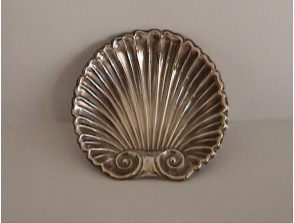
F. Shell
replica (width - 7 cm). Silver version of "Coquille St.
Jacques," the scallop shell used as the symbol of St. James the Great
of Compostela and worn on their hats or carried by devotees on their
pilgrimage to Santiago de Compostela, Spain. (© photo by Craig A. Gibson)
R.V.
Dietrich © 2015
Last
update: 11 December 2014
web page created by Emmett Mason
